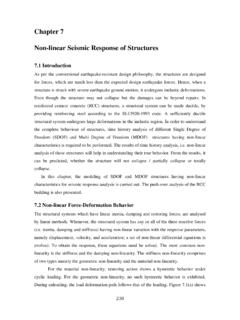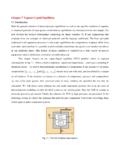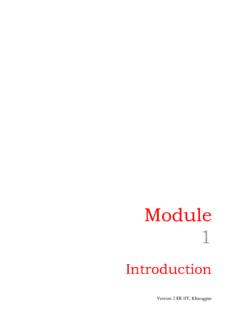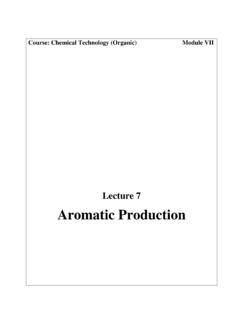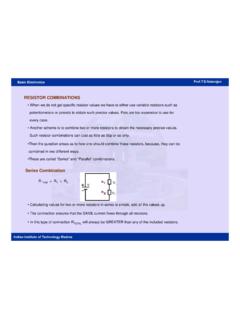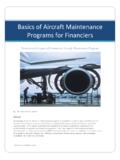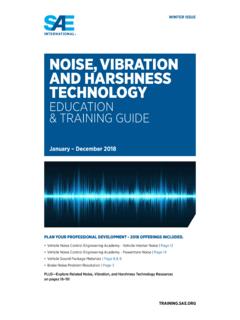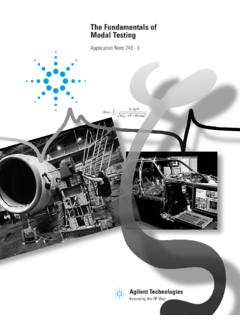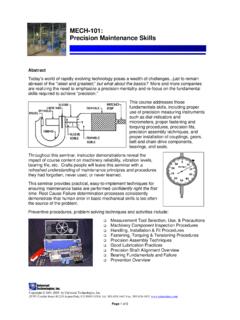Transcription of Chapter 37: Vibration Measurement Techniques: Basics ...
1 Chapter 37: Vibration Measurement Techniques: Basics introduction : Vibration is the back and forth or repetitive motion of an object from its point of rest. When a force is applied to the mass, it stretches the spring and moves the weight to the lower limit. When the force is removed, the stored energy in the spring causes the weight to move upward through the position of rest to its upper limit. Here, the mass stops and reverses direction traveling back through the position of rest to the lower limit. In a friction-free system the mass would continue this motion indefinitely. All real systems are damped, that is they will gradually come to their rest position after several cycles of motion, unless acted upon by an external force.
2 The characteristics of this vibratory motion are period, frequency, displacement, velocity, acceleration, amplitude and phase. Continued Vibration of this spring mass system would only repeat the characteristics shown in this single cycle. All rotating machines produce vibrations that are a function of the machine dynamics, such as the alignment and balance of the rotating parts. Measuring the amplitude of Vibration at certain frequencies can provide valuable information about the accuracy of shaft alignment and balance, the condition of bearings or gears, and the effect on the machine due to resonance from the housings, piping and other structures.
3 Vibration Measurement is an effective, non-intrusive method to monitor machine condition during start-ups, shutdowns and normal operation. Vibration analysis is used primarily on rotating equipment such as steam and gas turbines, pumps, motors, compressors, paper machines, rolling mills, machine tools and gearboxes. Vibration analysis is used to determine the operating and mechanical condition of equipment. A. major advantage is that Vibration analysis can identify developing problems before they become too serious and cause unscheduled downtime. This can be achieved by conducting regular monitoring of machine vibrations either on continuous basis or at scheduled intervals.
4 Regular Vibration monitoring can detect deteriorating or defective bearings, mechanical looseness and worn or broken gears. Vibration analysis can also detect misalignment and unbalance before these conditions result in bearing or shaft deterioration. Trending Vibration levels can identify poor maintenance practices, such as improper bearing installation and replacement, inaccurate shaft alignment or imprecise rotor balancing. Basic Characteristics of Vibrations: Modern Vibration monitoring has its genesis in the mid-1950s with the development and application of basic Vibration sensors, which are the heart of modern computerized condition monitoring systems.
5 Figure shows the traditional fundamental use of Vibration monitoring in rotating machinery, , to provide warning of gradually approached or suddenly encountered excessively high Vibration levels that could potentially damage the machinery. Trending a machine's Vibration levels over an extended period of time can potentially provide early warning of impending excessive Vibration levels and/or other problems and thus provide plant operators with valuable information for critical decision making to schedule a timely shutdown of a problem machine for corrective action, , rebalancing the rotor. For evaluating the machine vibrations, it is usually desirable to express frequency in terms of cycles per minute, since we measure the rotational speed of machinery in revolutions per minute.
6 This allows examination of the Vibration frequency in terms of multiples of the rotational speed. Rotational speed is also known as the fundamental frequency and the multiples of the fundamentals frequencies are known as its higher harmonics or super harmonics. Trip level Vibration Amplitude (m/s ) 2. Alarm level Sudden increase Time Fig. Vibration signature as Indicator There are three main parameters are measured to evaluate the Vibration characteristics of any dynamic system as displacement, velocity and acceleration. The peak-to-peak distance is measured from the upper limit to the lower limit, measured in mm to micron level. The velocity of a vibrating object is continually changing.
7 At the upper and lower limits, the object stops and reverses its direction of travel, thus its velocity at these two points is zero. While passing through the neutral or position of rest, the velocity is at its maximum. Since, the velocity is continually changing with respect to time, the peak or maximum velocity is always measured and commonly expressed in mm-per-second peak. When expressing the Vibration characteristic in terms of velocity, both the displacement and frequency are considered. Since, the vibrating object must reverse course at the peak displacements, this is where the maximum acceleration occurs. Like velocity, acceleration is constantly changing, and the peak acceleration is usually measured.
8 Displacement measurements can be important, especially in low frequency vibrations on machines that have brittle components. That is, the stress that is applied is sufficient to snap the component. Many machines have cast iron frames or cases that are relatively brittle and are subject to failure from a single large stress. Acceleration measurements are also important in that they directly measure force. Excessive force can lead to improper lubrication in journal bearings, and result in failure. The dynamic force created by the Vibration of a rotating member can directly cause bearing failure. Generally a machine can withstand up to eight times its designed static load before bearing failure occurs.
9 However, overloads as little as 10% can cause damage over an extended period of time. Although this seems insignificant, it can be shown that small unbalances can easily create sufficient dynamic forces to overload the bearings. The International Standards Organization (ISO), who establishes internationally acceptable units for Measurement of machinery Vibration , suggested the velocity . root mean square (rms) as the standard unit of Measurement . This was decided in an attempt to derive criteria that would determine an effective value for the varying function of velocity. Velocity rms tends to provide the energy content in the Vibration signal, whereas the velocity peak correlated better with the intensity of Vibration .
10 Higher velocity rms is generally more damaging than a similar magnitude of velocity peak. The crest factor of a waveform is the ratio of the peak value of the waveform to the rms value of the waveform. It is also sometimes called the peak-to- rms ratio'. The crest factor of a sine wave is , the peak value is times the rms value. The crest factor is one of the important features that can be used to trend machine condition. In discussing Vibration velocity, it was pointed out that the velocity of the mass approaches zero at extreme limits of travel. Each time it comes to a stop at the limit of travel, it must accelerate to increase velocity to travel to the opposite limit.

